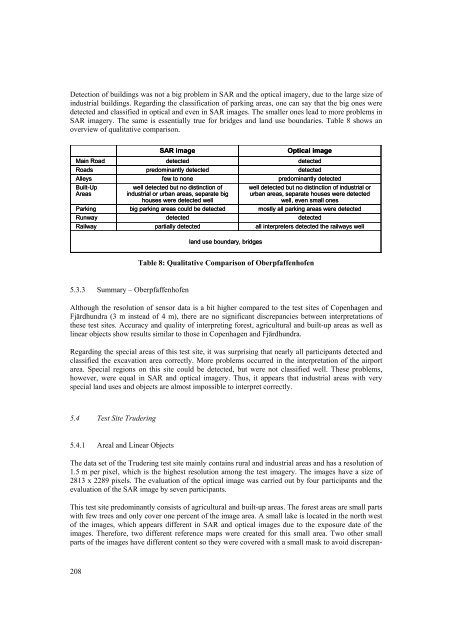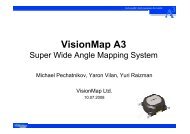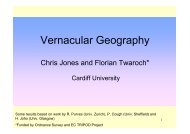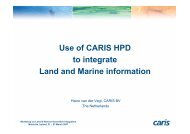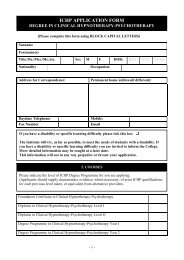Detection of buildings was not a big problem in SAR and the optical imagery, due to the large size of industrial buildings. Regarding the classification of parking areas, one can say that the big ones were detected and classified in optical and even in SAR images. The smaller ones lead to more problems in SAR imagery. The same is essentially true for bridges and land use boundaries. Table 8 shows an overview of qualitative comparison. Main Road Roads Alleys Built-Up Areas Parking Runway Railway 208 SAR image detected predominantly detected few to none well detected but no distinction of industrial or urban areas, separate big houses were detected well big parking areas could be detected detected partially detected 5.3.3 Summary – Oberpfaffenhofen land use boundary, bridges Optical image detected detected predominantly detected well detected but no distinction of industrial or urban areas, separate houses were detected well, even small ones mostly all parking areas were detected detected all interpreters detected the railways well Table 8: Qualitative Comparison of Oberpfaffenhofen Although the resolution of sensor data is a bit higher compared to the test sites of Copenhagen and Fjärdhundra (3 m instead of 4 m), there are no significant discrepancies between interpretations of these test sites. Accuracy and quality of interpreting forest, agricultural and built-up areas as well as linear objects show results similar to those in Copenhagen and Fjärdhundra. Regarding the special areas of this test site, it was surprising that nearly all participants detected and classified the excavation area correctly. More problems occurred in the interpretation of the airport area. Special regions on this site could be detected, but were not classified well. These problems, however, were equal in SAR and optical imagery. Thus, it appears that industrial areas with very special land uses and objects are almost impossible to interpret correctly. 5.4 Test Site Trudering 5.4.1 Areal and Linear Objects The data set of the Trudering test site mainly contains rural and industrial areas and has a resolution of 1.5 m per pixel, which is the highest resolution among the test imagery. The images have a size of 2813 x 2289 pixels. The evaluation of the optical image was carried out by four participants and the evaluation of the SAR image by seven participants. This test site predominantly consists of agricultural and built-up areas. The forest areas are small parts with few trees and only cover one percent of the image area. A small lake is located in the north west of the images, which appears different in SAR and optical images due to the exposure date of the images. Therefore, two different reference maps were created for this small area. Two other small parts of the images have different content so they were covered with a small mask to avoid discrepan-
cies in analysis. The following figures (Figure 29 - Figure 34) show the results of analyses for areal and linear objects. 120,00 100,00 80,00 60,00 40,00 20,00 0,00 Agriculture - sar Interpret 1 Interpret 3 Interpret 5 Interpret 7 Interpret 9 falsch positiv 1,18 2,12 1,12 1,42 0,44 falsch negativ 9,47 5,32 6,85 7,93 9,33 richtig 90,53 94,68 93,15 92,07 90,67 120,00 100,00 80,00 60,00 40,00 20,00 0,00 Built-Up - sar falsch positiv 5,13 11,05 10,39 12,82 19,44 falsch negativ 11,97 3,45 3,46 5,11 5,46 richtig 88,03 96,55 96,54 94,89 94,54 160,00 140,00 120,00 100,00 80,00 60,00 40,00 20,00 0,00 120,00 100,00 80,00 60,00 40,00 20,00 Figure 29: Trudering Result, Agricultural Area Interpret 1 Interpret 3 Interpret 5 Interpret 7 Interpret 9 Forest - sar falsch positiv 14,37 1,24 4,57 45,10 48,04 falsch negativ 55,05 39,95 33,52 41,84 49,88 richtig 44,95 60,05 66,48 58,16 50,12 0,00 Agriculture - optic Interpret 2 Interpret 4 Interpret 8 Interpret 10 falsch positiv 1,92 0,47 3,76 0,00 falsch negativ 5,40 9,19 2,67 0,00 richtig 94,60 90,81 97,33 0,00 120,00 100,00 80,00 60,00 40,00 20,00 0,00 Figure 30: Trudering Result, Built-Up Area Interpret 1 Interpret 3 Interpret 5 Interpret 7 Interpret 9 Built-Up - optic Interpret 2 Interpret 4 Interpret 8 Interpret 10 falsch positiv 13,51 12,00 8,58 0,00 falsch negativ 1,81 1,55 4,04 0,00 richtig 98,19 98,45 95,96 0,00 160,00 140,00 120,00 100,00 80,00 60,00 40,00 20,00 0,00 Figure 31: Trudering Result, Forested Area Forest - optic Interpret 2 Interpret 4 Interpret 8 Interpret 10 falsch positiv 0,36 3,50 19,03 33,67 falsch negativ 21,58 24,39 54,91 24,72 richtig 78,42 75,61 45,09 75,28 209
- Page 1 and 2:
European Spatial Data Research Nove
- Page 3 and 4:
PRESIDENT 2006 - 2008: Stig Jönsso
- Page 5 and 6:
H. Kaartinen and J. Hyyppä: EVALUA
- Page 7 and 8:
4.3.1 Data and study area..........
- Page 9:
2 QUESTIONNAIRES...................
- Page 13 and 14:
Abstract The objective of the EuroS
- Page 15 and 16:
The analysis of the structural qual
- Page 17 and 18:
Figure 2-3: Hermanni test site. Fig
- Page 19 and 20:
Espoonlahti Hermanni Senaatti Photo
- Page 21 and 22:
2.2 Reference Data 2.2.1 Field Meas
- Page 23 and 24:
Used data Time use Laser Aerial Gro
- Page 25 and 26:
Step 3: Import to CCModeler Figure
- Page 27 and 28:
Figure 3-4: Sequence of manual phot
- Page 29 and 30:
Figure 3-8: Workflow of laser scann
- Page 31 and 32:
Figure 3-11: Parametric building mo
- Page 33 and 34:
Each group of connected pixels clas
- Page 35 and 36:
Figure 3-18: Topological points and
- Page 37 and 38:
Detailed Description (Letters refer
- Page 39 and 40:
assumption is made: the two longest
- Page 41 and 42:
Figure 3-25: A 3D building model wi
- Page 43 and 44:
ICC used the same methods as Nebel
- Page 45 and 46:
where p75th is the value at the 75
- Page 47 and 48:
CyberCity Stuttgart Hamburg IGN ICC
- Page 49 and 50:
CyberCity Hamburg Stuttgart IGN ICC
- Page 51 and 52:
Height Cyber- City Hamburg Stuttgar
- Page 53 and 54:
Height Cyber- City Stuttgart IGN IC
- Page 55 and 56:
Height Cyber- City Stuttgart IGN IC
- Page 57 and 58:
Height Cyber- City HamburgStuttgart
- Page 59 and 60:
Height Cyber- City HamburgStuttgart
- Page 61 and 62:
All targets Eaves Ridges Height IGN
- Page 63 and 64:
CyberCity achieved a good quality i
- Page 65 and 66:
Point density, shadowing of trees a
- Page 67 and 68:
Height accuracy IQR [m] 1.6 1.4 1.2
- Page 69 and 70:
All Cyber- Ham- ICC laser+ Nebel+ I
- Page 71 and 72:
All Cyber- HamStutt- ICC laser+ Neb
- Page 73 and 74:
In building length determination (F
- Page 75 and 76:
degrees, std 6.3 degrees). In Senaa
- Page 77 and 78:
5 Discussion and Conclusions It can
- Page 79 and 80:
References Alharthy A. and Bethe, J
- Page 81 and 82:
Fraser, C.S., Baltsavias, E. and Gr
- Page 83 and 84:
Khoshelham K., 2004. Building Extra
- Page 85 and 86:
Sequeira, V., Ng, K., Wolfart, E.,
- Page 87 and 88:
Index of Figures Figure 2-1: Senaat
- Page 89:
Index of Tables Table 2-1: Aerial i
- Page 92 and 93:
90 Senaatti by Delft. Wireframe mod
- Page 94 and 95:
92 Espoonlahti by IGN, with and wit
- Page 96 and 97:
94 Senaatti by IGN, with and withou
- Page 98 and 99:
96 Hermanni by Aalborg.
- Page 100 and 101:
98 CyberCity ICC laser+aerial ICC l
- Page 102 and 103:
100 IGN FOI outlines Nebel+Partner
- Page 105 and 106:
Difference Images, Whole Test Site,
- Page 107 and 108:
Difference Images, Whole Test Site,
- Page 109 and 110:
Difference Images, Modelled Buildin
- Page 111 and 112:
Difference Images, Modelled Buildin
- Page 113:
EuroSDR-Project Commission 2 “Ima
- Page 116 and 117:
2 Project highlights The project Ch
- Page 118 and 119:
116 Feature Characteristics Object
- Page 120 and 121:
New are those combinations that ind
- Page 122 and 123:
120 Figure 4-1: Orthophotomosaic fr
- Page 124 and 125:
4.1.2 Segmentation The first step o
- Page 126 and 127:
124 Class Features Vegetation Ratio
- Page 128 and 129:
4.1.4 Change map As the results of
- Page 130 and 131:
Two types of changes were assigned
- Page 132 and 133:
130 Figure 4-11: Evaluation of chan
- Page 134 and 135:
132 Figure 4-13: Orthophotos of stu
- Page 136 and 137:
different villages were identified
- Page 138 and 139:
136 Figure 4-16: Change maps of Swi
- Page 140 and 141:
spectral reflectance. Shadows (blac
- Page 142 and 143:
140 Figure 4-19: Change map of Germ
- Page 144 and 145:
Figure 4-21: Diagnostics as given b
- Page 146 and 147:
144 Automatic Accepted Rejected Hum
- Page 148 and 149:
4.4.2 Segmentation, classification
- Page 150 and 151:
differentiated very well. The chang
- Page 152 and 153:
150 Figure 4-31: Ultracam real-colo
- Page 154 and 155:
152 Figure 4-35: Classification of
- Page 156 and 157:
154 Figure 4-38: Subset of change m
- Page 158 and 159:
5 Conclusions and Outlook In this p
- Page 161: Annex 1 EuroSDR Change Detection Wo
- Page 164 and 165: What is the impact of changing spat
- Page 167: Annex 2 Paper presented at IGARSS05
- Page 170 and 171: covering 2 x 2 km with reference da
- Page 172 and 173: 170 Red roof Bright object 0 20 40
- Page 175: Annex 3 EuroSDR CD Workshop Nicosia
- Page 178 and 179: 176 method 1 indicates land cover c
- Page 181: Annex 4 Comments on change map by B
- Page 184 and 185: enzen mehr zu erwarten. Doch laut
- Page 187 and 188: Abstract The EuroSDR “Sensor and
- Page 189 and 190: 2 Test Sites and Test Data The test
- Page 191 and 192: Figure 3: Data set Fjärdhundra, ag
- Page 193 and 194: The map of Sweden is only available
- Page 195 and 196: 3.2 Accounting for Different Acquis
- Page 197 and 198: 4 Analysis 4.1 Basic Information In
- Page 199 and 200: 4.2.2 Linear Objects Since it is no
- Page 201 and 202: 5 Results of Phase I 5.1 Test Site
- Page 203 and 204: 5.1.2 Qualitative Comparison In add
- Page 205 and 206: 140,0 120,0 100,0 80,0 60,0 40,0 20
- Page 207 and 208: 5.3 Test Site Oberpfaffenhofen 5.3.
- Page 209: 140,0 120,0 100,0 80,0 60,0 40,0 20
- Page 213 and 214: 5.4.2 Qualitative Comparison The ra
- Page 215 and 216: Acknowledgments We thank all partic
- Page 217: Index of Tables Table 1: Contest Ph
- Page 221 and 222: Abstract Roads are important object
- Page 223 and 224: overview over the whole area. We ra
- Page 225 and 226: m and above no longer plays an impo
- Page 227 and 228: 3 Test Data and Evaluation Criteria
- Page 229 and 230: and straight enough. • Markus Ger
- Page 231 and 232: Name (best) Test area Completeness
- Page 233 and 234: • ADS40_1 and 2: Results for both
- Page 235 and 236: • Ikonos1_Sub1: This image shows
- Page 237 and 238: Figure 7: Ikonos3_Sub1 - Bacher; co
- Page 239 and 240: Finally, we want to note some impor
- Page 241 and 242: load nor response time for anybody
- Page 243: Zhang, C., 2004. Towards an Operati
- Page 246 and 247: objects, and their cooperation with
- Page 248 and 249: Belgium, provided by their NMCAs. H
- Page 250 and 251: Possibly only parts of images will
- Page 252 and 253: How many people are employed in you
- Page 254 and 255: 7. What is the average time differe
- Page 256 and 257: - what is the degree of completenes
- Page 259 and 260: Appendix 3: Questionnaire for Resea
- Page 261 and 262:
If others please specify: 2. What d
- Page 263 and 264:
Complex crossings (more than 4 road
- Page 265 and 266:
Combination of a) or b) with c) [0]
- Page 267 and 268:
If yes, using: DTM and / or [2] D
- Page 269 and 270:
Appendix 4: General Characteristics
- Page 271:
Most important features for practic
- Page 274 and 275:
IKONOS The images come from the SI
- Page 277:
Appendix 6: Documentation by Beumie
- Page 281 and 282:
Appendix 8: Documentation by Zhang
- Page 283 and 284:
LIST OF OEEPE/EuroSDR OFFICIAL PUBL
- Page 285 and 286:
25 Ducher, G.: Test on Orthophoto a


